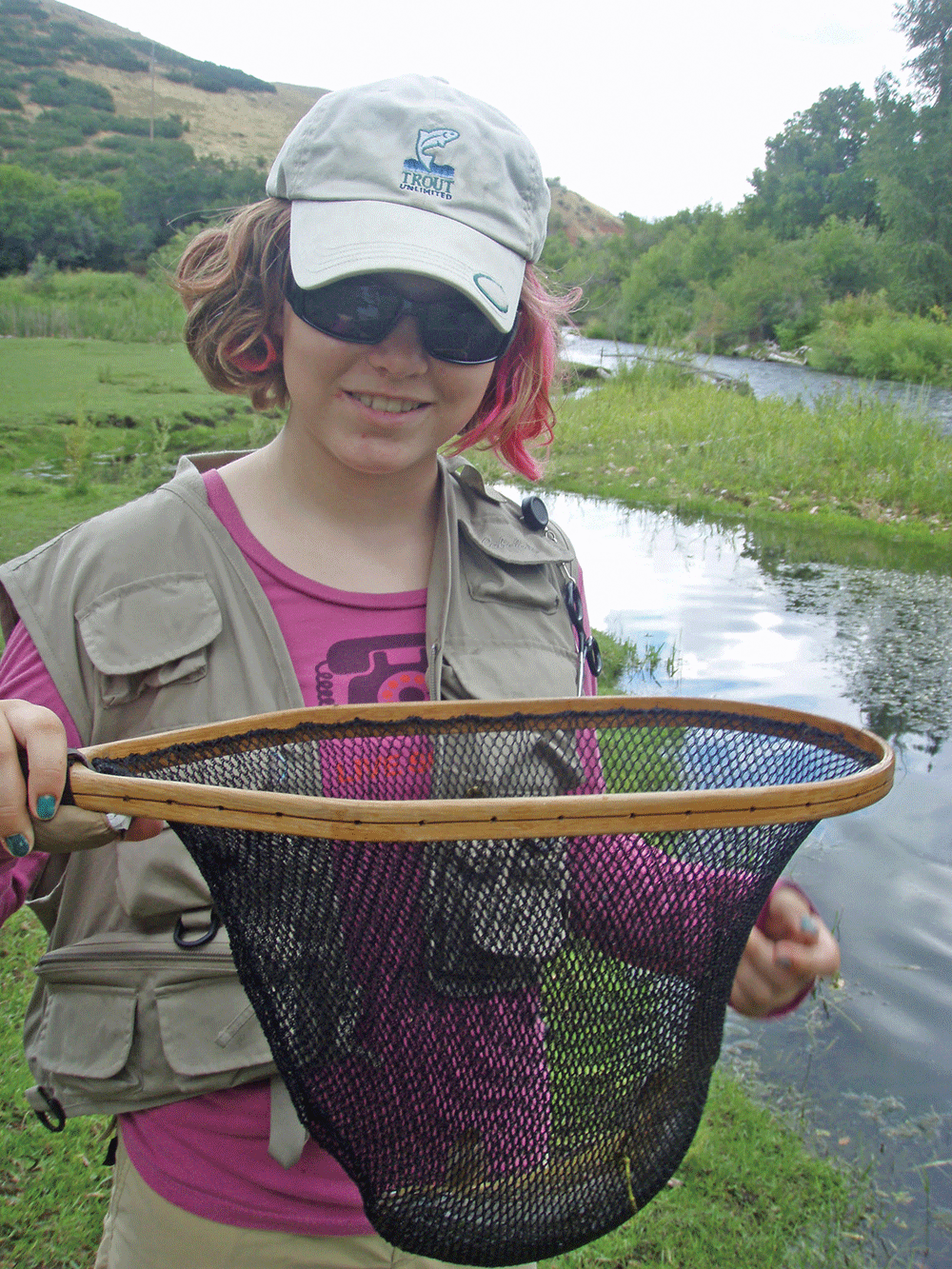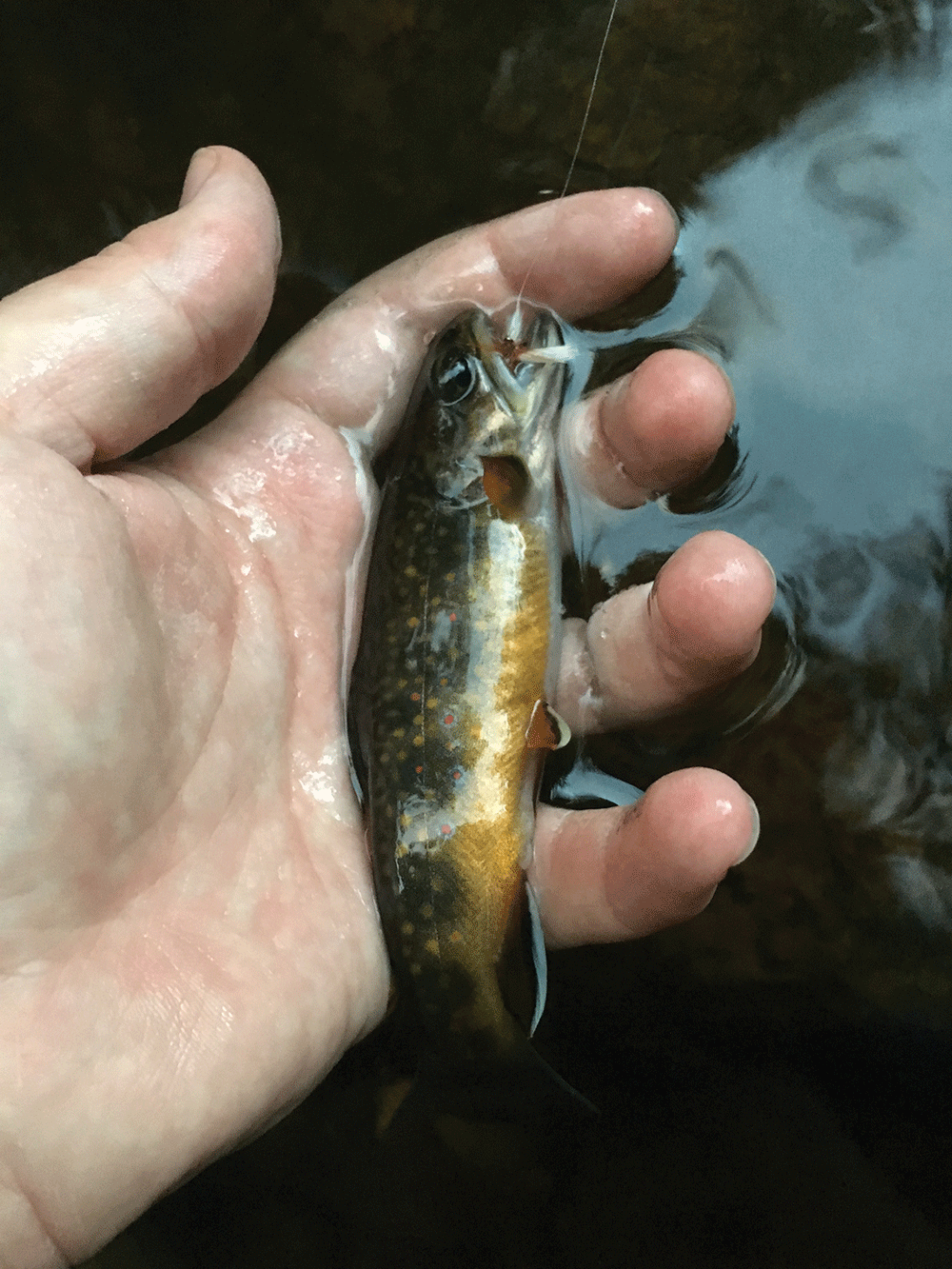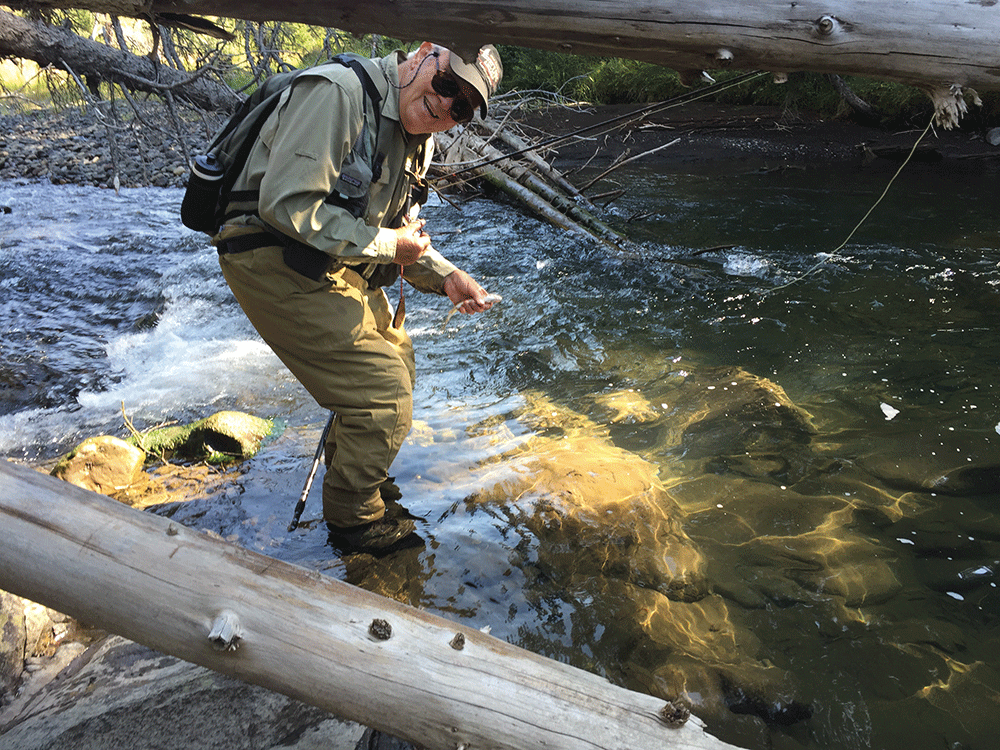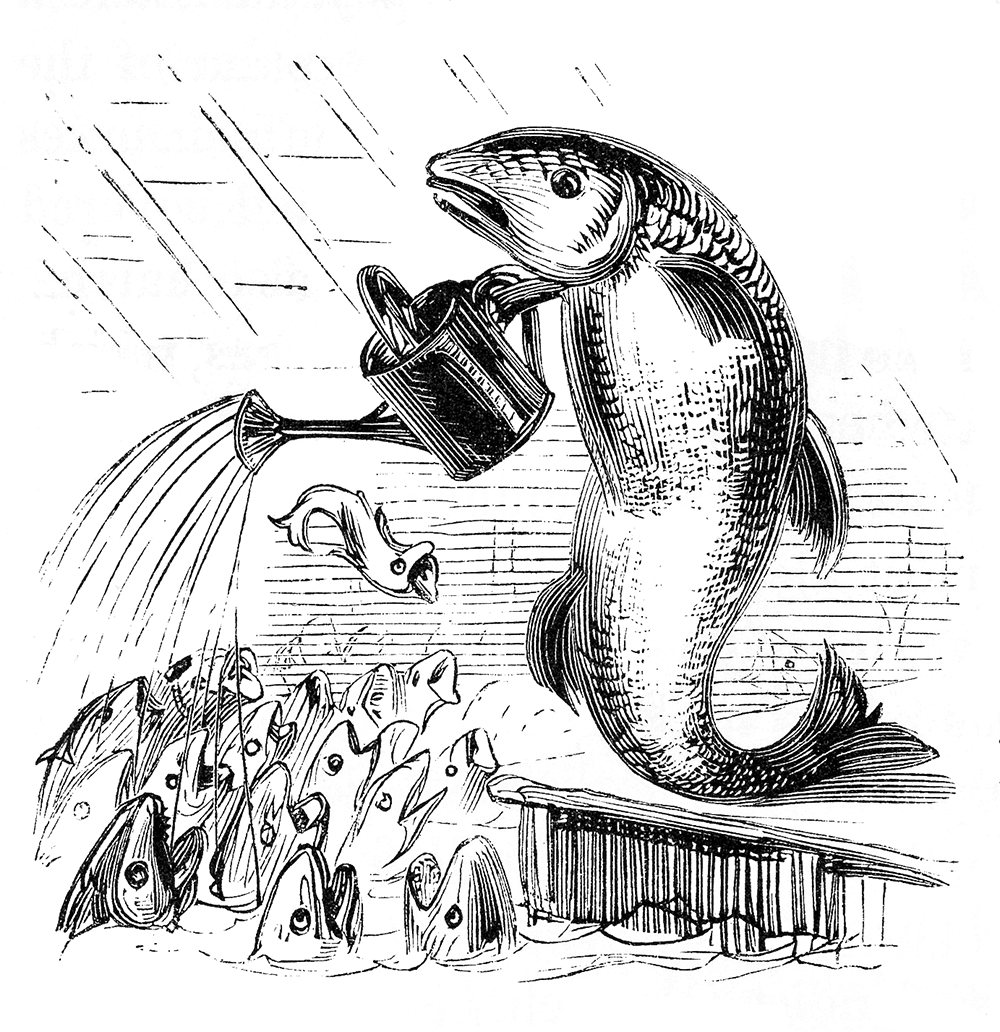by Jan Harold Brunvand
The terms we use to describe big fish—especially the ones that got away—are fairly limited and predictable. These are lunkers, monsters, giants, whoppers, whales, and the like. At one end of the sophistication scale, we Americans might say hawg; at the other end, our more poetic British ancestors sometimes chose leviathan.
The terms used for very small fish tend to be more creative and varied, often suggesting some measure of pretentiousness and gullibility on the part of the little fellow or chap. Although big fish are thought of as wary, wise, and educated, tiddlers, as I usually call them, are regarded as foolish, impetuous, and naive. Small fish are often personified as small people. A fry is a baby fish, but a small fry is a little person of similar importance.
Even the common diminutive forms of species’ names suggest condescension. We hear of brookies, brownies, and dollies (for Dolly Varden), as well as bows and cutts (but seldom, if ever cutties).

The author’s granddaughter, Charlotte (“Charley”), with a small trout in a big net. Photo by Jan Harold Brunvand.

A monster of a Vermont brook trout. Photo by Peter Nardini
Personifying the members of what was sometimes called the finny tribe started early. John Dennys’s The Secrets of Angling (1613) was written in the form of a poem composed of 151 eight-line verses. In a verse beginning “Some youthful Gallant here perhaps will say/This is no pastime for a gentleman,”1 Dennys listed gambling with cards or dice, fencing, dancing, and courting as more fit gentlemanly amusements than wasting time “a silly Fish to catch.”2 Fish, of course, are neither silly nor dignified; they are simply fish.
Izaak Walton quoted several of Dennys’s stanzas in defense of angling—although not the one about “silly Fish.” It remained for Charles Cotton in his 1676 Instructions supplement to the fifth edition of The Compleat Angler to refer to a small fish as “a diminutive gentleman”3 and to advise the angler “e’en throw him in again, and let him grow.”4
In subsequent angling literature, the tradition continued of characterizing small fish as small people. Diminutive is again the term used by William Scrope in his Days and Nights of Salmon Fishing in the River Tweed (1885), which he wrote about one smallish fish, “but, dwarf as he was, he thought a good deal of himself, and was prodigal of the little strength which nature had given him. I thought him conceited and so hauled him on shore at once without any ceremony. He proved to be a river trout of four pounds,—a silly-looking creature enough.”5 A 4-pound dwarf! It depends on what you are fishing for. Scrope revealed his prejudice when he wrote that before becoming salmon fishers, men “generally acquire some skill in river angling for trout, and such like pigmies.”6
Andrew Lang, in Angling Sketches (1891), seldom characterized a small fish as a diminutive human (he did once write of “small fellows”7), but he varied his terminology for tiddlers using words like minnow and fingerling and phrases like tiny and eager. Describing the first fish he caught as a boy, he called it a troutling.8 The cuteness is there, if not the personification.
Describing an 1876 fishing trip in Connemara, E. S. Roscoe, in Rambles with a Fishing-Rod (1883), mentioned an Irish term he encountered: jackeen. A half-pound jackeen was perfect for a breakfast, and he continued, “by this name are those spirited little fellows, small sea-trout, known in the West of Ireland, which, for their size and strength, are the gamest fish that swim.”9 The Oxford English Dictionary defines jackeen as “a contemptuous designation for a self-assertive worthless fellow,” citing the earliest occurrence as 1840.10 The explanation of the term is a bit complicated. Jack, a nickname for John, supposedly evokes the image of a Dubliner resembling an Englishman, both via the John Bull stereotype and an echo of the term Union Jack. The suffix –een makes Jack an unremarkable small fellow. According to the Wikipedia entry, jackeen is still used to describe Dublin athletes and supporters of the GAA (Gaelic Athletic Association);11 whether it is still used to refer to a little fish, I don’t know.
Another British writer continuing this tradition of referring to tiddlers as foolish fellows was J. C. Mottram, who, in Fly-Fishing: Some New Arts and Mysteries (1915), wrote of “fish of little or no education, who will, of course, take anything.”12 In another passage, Mottram wonders whether he has hooked “a good one or a little chap.”13
In one of the first notable American works on fishing, Thaddeus Norris (“Uncle Thad”) wrote in The American Angler’s Book (1864) of fingerlings, small fry, and “little fellows—eight and nine inches—the very size for the pan.”14 Here he anticipates the common idea of keeping what are termed pan-sized fish for eating. In romanticizing a boy’s earliest days of fishing, as so many angling authors still do, Uncle Thad described a young lad “[returning] home at night weary and footsore, but exulting in his string of chubs, minnows, and sunnies, the largest as broad as his three fingers!”15 Small fry are happy merely catching small fry.
Theodore Gordon, the so-called father of American dry-fly fishing, wrote many letters and articles about the sport, and he found several ways to describe fish size. For large trout, he sometimes used the terms sockdollager, jumbo, and buster (perhaps for one that would bust your tackle). Gordon’s favorite terms for tiddlers were baby trout, small chaps, and little chaps. In a typical passage, quoted in John McDonald’s The Complete Fly Fisherman: The Notes and Letters of Theodore Gordon (1947), Gordon wrote, “The American trout is a game chap. I have seen one not over eight inches in length go for a big disabled dragonfly until he got it under and kept it.”16
Observing tiny trout go after ovipositing aquatic insects inspired George M. L. La Branche to use a wonderfully obsolete term for ambitious tiddlers. Here it occurs in a passage from The Dry Fly and Fast Water (1914):
One who observes closely will see that at the moment the female [mayfly] approaches the water, or during her subsequent dips, attempts, frequently successful, are made by the fish to capture her. As these efforts required some activity, they are resorted to usually by the more agile dandiprats. The larger fish are quite as interested in the dainty morsel as are their younger brothers, but they do not make the same frantic efforts to secure it.17

On Soda Butte Creek in Yellowstone National Park, where the author found a lot of dandiprats eager for his flies in a pool surrounded by downed timber. Photo by Judy Brunvand.
Dandiprats—what a wonderful word! It suggests both the vain foppery of a human dandy and the spectacle of a pratfall—that is, “a humiliating mishap or blunder” as my desk dictionary defines it.18 La Branche used the term again with reference to a promising pool in a stream that “looks as if it should contain a big fish . . . [yet] yields but a few dandiprats.”19
The OED offers no etymology for dandiprat, so my notions expressed above are mere guesswork. The definitive Oxford English Dictionary records examples of its use, beginning in the early sixteenth century: first for a small coin and later for “a small, insignificant, or contemptible fellow.”20 A third sense is that of “a young lad, little boy, urchin; rarely . . . a young girl.”21 All three are labeled obsolete and archaic. A typical illustrative quotation from 1718 reads, “I saw a little Dandiprat riding about, who, they said was a hugeous great Lord.”22 The most recent citation in the OED, dated 1872, refers to “a bit of a chit of a boy . . . [a] snickering dandiprat.”23 Unmentioned in the OED is the occurrence of the word in an English nursery rhyme included in Iona and Peter Opie’s compilation The Oxford Dictionary of Nursery Rhymes (1951), which begins, “Little Jack Dandy-prat was my first suitor;/He had a dish and a spoon, and had some pewter.”24 The items mentioned are evidently the simple household items this unremarkable suitor could bring to a marriage. The Opies cite examples of “Little Jack Dandy-prat” from 1810 and 1844.
George M. L. La Branche (1875–1961) was a wealthy and successful man, described by Paul Schullery in his introduction to the 1998 reissue of The Dry Fly and Fast Water as one of “American fly fishing’s most polished, dapper, and articulate writers.”25 La Branche may have come upon the term dandiprat in his readings, or it’s possible someone of his acquaintance in the New York City gentlemen’s angling scene was still using such an old-fashioned word, even in the early twentieth century. Whatever his source, it’s a lovely word to describe a tiny trout, and I think it should inspire some modern fly tier to create a dandiprat pattern. (Who better than Dandy Reiner, owner of the Hatch Finders Fly Shop in Livingston, Montana, and creator of the Pink Pookie fly? I proposed this project to Ms. Reiner last summer at the International Federation of Fly Fishers fair in Livingston, and she agreed to keep it in mind. Stay tuned!)
In searching other classic fly-fishing writings for terms referring to lunkers versus tiddlers, I’ve most recently checked John Atherton’s The Fly and the Fish (1951). Atherton had fished with La Branche, among several other gurus of the sport, but, no, he didn’t pick up the term dandiprat. However, he did imagine small fish as little humans in this passage: “The trout in that pool were wary; I imagine that the ones which finally came to our flies were the less experienced, and I always wondered, when we unhooked them and sent them back with our blessing, whether they communicated their adventures to their brethren.”26 Atherton (1900–1952) is also the most recent writer I’ve found to dub a large trout a leviathan. As for the charms of catching tiddlers versus lunkers, Atherton wrote, “I would greatly prefer a day in which the rewards were three or four medium-sized fish than one spent in pursuit of a single big one. The angler who has a passion for big fish only, at any cost, is missing a great deal the charm of the sport by not simply taking things as they come.”27
I wholeheartedly agree, possibly because most of the fish I catch are medium sized at best. Part of the charm of the sport for me lies in reading the well-expressed sentiments of brothers of the angle who may employ such a charming old word as dandiprat for a silly little fish.
This article first appeared in the Summer 2017 issue (Vol. 43 No. 3) issue of the American Fly Fisher.
Endnotes
- J[ohn] D[ennys] Esquire, The Secrets of Angling (1613). A reprint, with introduction by Thomas Westwood (London: W. Satchell & Co., 1883), 30.
- Ibid.
- Charles Cotton, The Compleat Angler, Part II. Being Instructions How to Angle for a Trout or Grayling in a Clear Stream, in Izaak Walton, The Compleat Angler, or, The Contemplative Man’s Recreation (1676 ed.) Reprint with an introduction by James Russell Lowell (New York: The Heritage Press, 1948), 272.
- Ibid.
- William Scrope, Days and Nights of Salmon Fishing in the River Tweed (London: Hamilton, Adams, & Co. and Glasgow: Thomas D. Morison, 1885), 191.
- Ibid., 21.
- Andrew Lang, Angling Sketches (London: Longmans, Green, and Co., 1891), 99.
- Ibid., 15.
- E. S. Roscoe, Rambles with a Fishing-Rod (Edinburgh and London: William Blackwood and Sons, 1883), 47.
- The Oxford English Dictionary: The definitive record of the English language (Oxford: Oxford University Press, 2016), online ed., s.v. “jackeen.” Accessed via University of Utah Library, 23 February 2017, at oed.com.ezproxy.lib.utah.edu.
- “Jackeen,” Wikipedia, https://en.wikipedia.org/wiki/Jackeen. Accessed 24 February 2017.
- J. C. Mottram, Fly-Fishing: Some New Arts and Mysteries, Fly Fisherman’s Gold Library reprint of the 1921 edition (Lyon, Miss.: Derrydale Press, 1994), 168.
- Ibid., 170.
- Thaddeus Norris, The American Angler’s Book, Fly Fisherman’s Gold Library reprint of 1864 edition (Lyon, Miss.: Derrydale Press, 1994), 580.
- Ibid., 28.
- Theodore Gordon, in John McDonald, ed., The Complete Fly Fisherman: The Notes and Letters of Theodore Gordon, reprint of material in 1968 edition (New York: Nick Lyons Books, 1989), 41–42.
- George M. L. La Branche, The Dry Fly and Fast Water, reprint with an introduction by Paul Schullery (Helena, Mont.: Greycliff Publishing Company, 1998), 44.
- Webster’s Seventh New Collegiate Dictionary (Springfield, Mass.: G. & C. Merriam Company, 1963), s.v. “pratfall.”
- La Branche, The Dry Fly, 89.
- The Oxford English Dictionary, online ed., s.v. “dandiprat.” Accessed 23 February 2017.
- Ibid.
- Ibid.
- Ibid.
- Iona Opie and Peter Opie, Item no. 261, The Oxford Dictionary of Nursery Rhymes (Oxford: Clarendon Press, 1951), 234.
- Paul Schullery, introduction to La Branche, The Dry Fly and Fast Water, xiv.
- John Atherton, The Fly and the Fish, reprint of 1951 edition (Mineola, N.Y.: Dover Publications, Inc., 1971), 183.
- Ibid., 186.

From Genio C. Scott, Fishing in American Waters (New York: Harper & Brothers, Publishers, 1869), 355.

